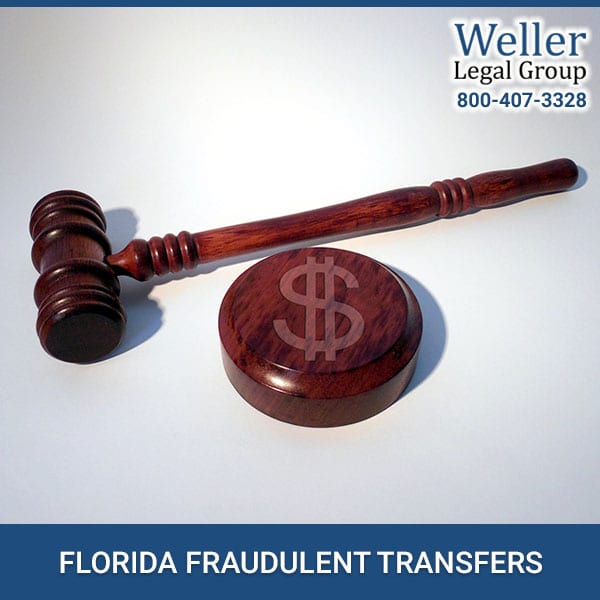 Florida has a statutory provision, formally referred to as the Uniform Fraudulent Transfer Act. (726.101)
Florida has a statutory provision, formally referred to as the Uniform Fraudulent Transfer Act. (726.101)
Florida Statute 726.105 governs when transfers are considered fraudulent as to present and future creditors.
These ELEMENTS must be present for a transfer to be considered fraudulent:
- TRANSFER made or OBLIGATION incurred by a DEBTOR
- CREDITORS claim can arise BEFORE or AFTER the obligation was incurred
- DEBTOR made TRANSFER with:
ACTUAL INTENT to hinder, delay, or defraud any creditor of the debtor
OR
(CONSTRUCTIVE INTENT) DEBTOR did not receive REASONABLY EQUIVALENT VALUE in
exchange for the TRANSFER OR OBLIGATION
AND
Was engaged or about to engage in a transaction for which the remaining assets of the debtor
were unreasonably small in relation to the business or transaction
OR
Intended to incur, or believed or reasonably should have believed that he or she would incur,
debts beyond his or her ability to pay as they become due
FACTORS IN DETERMINING ACTUAL INTENT [726.105(2)]
- Transfer or obligation was made to an INSIDER
- Debtor retained POSSESSION or CONTROL of the property AFTER the transfer
- TRANSFER or OBLIGATION was DISCLOSED or CONCEALED
- Debtor was threatened with a LAWSUIT before the transfer
- Transfer was SUBSTANTIALLY ALL the Debtor’s assets
- Debtor absconded
- Debtor REMOVED or CONCEALED assets
- Whether the VALUE of the CONSIDERATION received by the Debtor was REASONABLY
EQUIVALENT to the value of the asset transferred or the amount of the obligation incurred - Debtor was INSOLVENT or BECOME INSOLVENT shortly after the transfer was made or the
obligation incurred - Transfer occurred shortly before or after a SUBSTANTIAL DEBT was incurred
Therefore, in determining whether a TRANSFER is considered FRAUDULENT under the Florida Statute, the Courts will consider whether ACTUAL or CONSTRUCTIVE INTENT exists. A Creditor outside of Bankruptcy can bring an action against a Debtor, to seek to void any transfer that may be deemed to be a Fraudulent Transfer under Section 726 of the Florida Statutes. In Bankruptcy, the Bankruptcy Trustee may seek to avoid certain transfers by employing the same Statute.
Florida Statute 726.110 Extinguishment of cause of action refers to what is commonly called the Statute of Limitations. Certain lawsuits must be brought within a prescribed period of time. One of the defenses available to the Debtor is that the action brought by the Creditor exceeds the allowable time period prescribed by the Statute of Limitations.
One should carefully read the Florida Statutes, because the Statute of Limitations differs in cases in which ACTUAL versus CONSTRUCTIVE INTENT is present. Florida Statute 726.110(1) states that under section 726.105(1)(a), which addresses ACTUAL INTENT, an action must be brought within 4 years after the transfer was made or obligation incurred or if later, within one year after the transfer or obligation was or could reasonably have been discovered by the Creditor or claimant.
Florida Statute section 726.101(1)(b), which pertains to CONSTRUCTIVE INTENT, permits a 4 year Statute of Limitations, without the additional 1 year provision for when the transfer could reasonably been discovered by the Creditor or claimant. Florida Statute section 726.106(1) pertains to transfers made as to present creditors. Any actions brought pursuant to this section is also restricted by a four year Statute of Limitations.
BANKRUPTCY APPLICATION
The issue of Fraudulent Transfers is prevalent in Bankruptcy proceedings, particularly in the arena of Chapter 7 Bankruptcy. Although the Bankruptcy Petition refers primarily to any transfers made within two years of the date of the filing of the Bankruptcy petition, in reference to Federal rules regarding transfers, the Chapter 7 Trustee may also employ the Transfer Statutes of the State in which the Bankruptcy petition was filed. The Florida Statutes give the Chapter 7 Trustee a much longer period of time from the date of the transfer, to bring a successful AVOIDANCE ACTION pursuant to the Trustee’s AVOIDANCE POWERS. In the Middle District of Florida, Tampa Division, for example, the Chapter 7 Trustees will invariably ask about any transfers made within the previous five years.
Picture Credit: Pixabay

